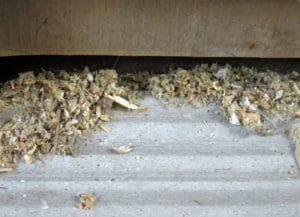Jonathan writes: I have been finding little piles of wood shavings on my backyard deck, along the bottom of the exterior wall of the house (see photo). Does this look like a sign of carpenter ants or termites? I suspect ants as I sometimes see large, black ants in the house. What’s the best way to get rid of carpenter ants?

Steve Bliss, of BuildingAdvisor.com, responds: Wood shavings like these are most likely the work of carpenter ants. Carpenter ants excavate wood for nesting, but do not eat wood like termites do. Instead they leave little piles of shavings and course sawdust below their nesting areas.
Like termites, carpenter ants are attracted to wood that is wet and softened by wood decay. Termites eat the wood and leave droppings (frass), which consists of very small pellets, ranging from light brown to black in color. Piles of very fine sawdust might be evidence of powderpost beetles.
To get rid of carpenter ants, the first step is to solve the water leakage problem. This will prevent further rot and discourage the carpenter ants from taking up residence. If the damage to the framing and sheathing is extensive, you may need to open up the wall and repair the damaged section.
If your home lies in a wooded area, it is difficult to keep carpenter ants out of your house altogether. Even if they are not living in the walls, these large black ants may visit the house regularly to forage for food. By living in the woods, you are in the middle of their natural habitat.

A very effective and non-toxic treatment for carpenter ants is boric acid, which you can buy at any hardware store. Sprinkle it liberally along the paths favored by the ants – behind and under kitchen appliances, for example.

If you are building in a wooded area, it’s a good idea to liberally sprinkle boric acid along the bottom plate of your wall framing and other hidden cavities before they are enclosed. The boric acid will continue working for many years.
Boric acid, also called borax, is the same substance used in the old washing formula “20 Mule Team Borax”. It is harmless to humans and pets, but toxic to carpenter ants and termites. Wood treated with borates provides a non-toxic alternative to pressure-treated wood, but it cannot be used in exterior applications because the borates will gradually leach out of the wood when exposed to rain.
Read more on Termite Damage
Leave a Reply